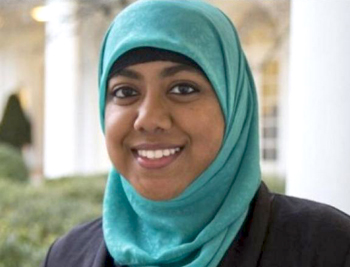Washington, Feb 27: A bold Hijab-wearing Muslim ex-White House staffer of Bangladeshi-origin has said she quit her job after US President Donald Trump announced his controversial travel ban, lasting just eight days in the new administration.
 Rumana Ahmed was hired in 2011 to work at the White House and eventually the National Security Council (NSC).
Rumana Ahmed was hired in 2011 to work at the White House and eventually the National Security Council (NSC).
"My job there was to promote and protect the best of what my country stands for. I am a hijab-wearing Muslim woman I was the only hijabi in the West Wing and the Obama administration always made me feel welcome and included," she wrote in an article published in The Atlantic.
Ahmed said that like most of her fellow American-Muslims, she spent much of 2016 watching with "consternation" as Trump "vilified our community".
"Despite this or because of it I thought I should try to stay on the NSC staff during the Trump Administration, in order to give the new president and his aides a more nuanced view of Islam, and of America's Muslim citizens.
"I lasted eight days. When Trump issued a ban on travellers from seven Muslim-majority countries and all Syrian refugees, I knew I could no longer stay and work for an administration that saw me and people like me not as fellow citizens, but as a threat," she said.
Ahmed said the evening before she left her job at the White House, she notified Trump's senior National Security Council (NSC) communications adviser, Michael Anton, of her decision.
"His initial surprise, asking whether I was leaving government entirely, was followed by silence -- almost in caution, not asking why. I told him anyway," she wrote.
"I told him I had to leave because it was an insult walking into this country's most historic building every day under an administration that is working against and vilifying everything I stand for as an American and as a Muslim," Ahmed said.
She told Anton that the administration was attacking the basic tenets of democracy. She said Anton just looked at her and said nothing.
Ahmed, whose parents immigrated to the US from Bangladesh in 1978, said inspired by then president Barack Obama, she joined the White House in 2011, after graduating from the George Washington University.
"The days I spent in the Trump White House were strange, appalling and disturbing," she wrote.
Ahmed's personal account comes amid a spike in incidents of intimidation and assault targeting hijab-wearing women across the US following Trump's electoral triumph.





Comments
This wicked Trump is another face of Iblees and hope he will be taught good lesson by Americans in near future. He is ruining US and giving rise to hate. He is trying to be modern world Hitler like the one in another part of this world.
Add new comment